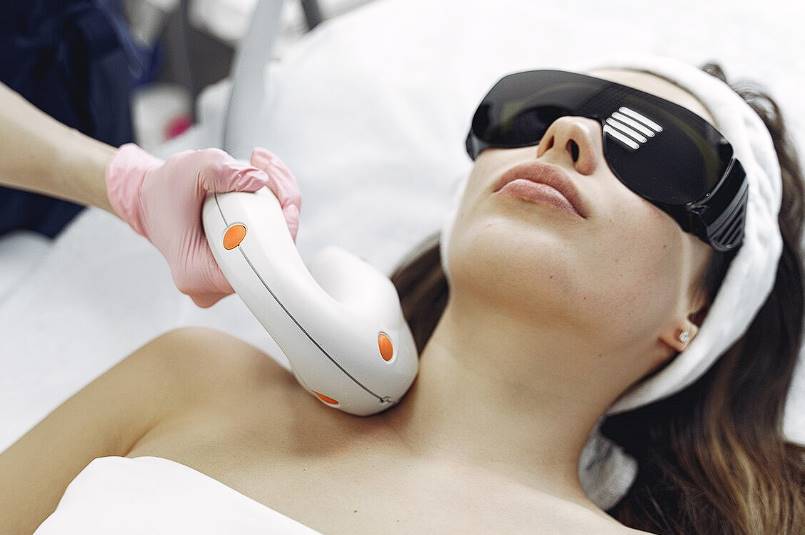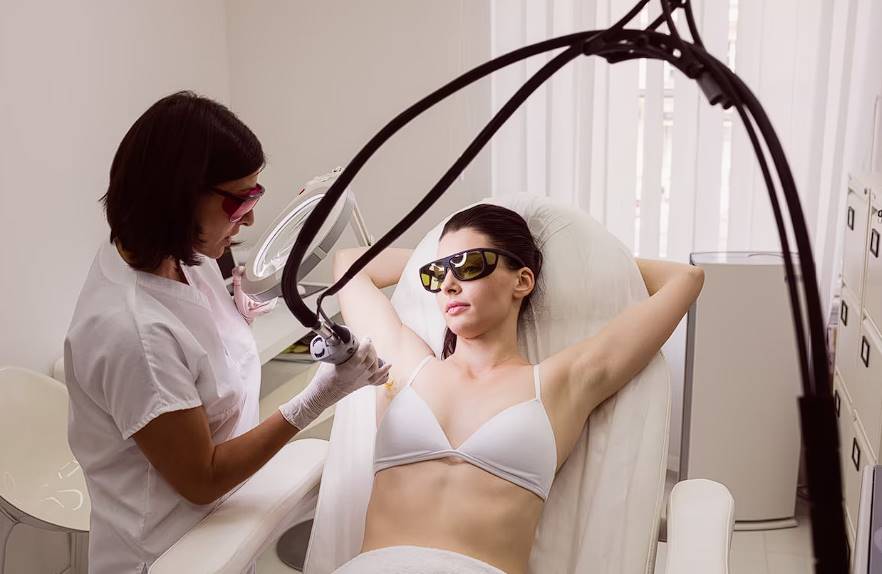When it comes to getting rid of excess hair, many people turn to the tried-and-true technique of laser hair removal. The permanence of the effects of laser hair removal is one of its primary benefits.
In contrast to more time-consuming and ineffective treatments like shaving, waxing, or applying depilatory lotions, laser hair removal actually slows hair growth for good.
Laser hair removal is effective because it destroys hair follicles in their whole, eliminating them permanently. Hair follicles' melanin absorbs the laser's intense beam of light throughout the process.
The hair follicles are damaged during this process, reducing their regenerative potential. Even though laser hair removal can't eliminate hair growth entirely for everyone, it does greatly diminish it. After a few treatments, many people see a significant reduction in their hair.
Results may last longer or shorter than expected depending on factors such as the individual's skin type, hair colour, and the treated area. After a few treatments, most patients see a marked reduction in hair growth that can continue for months or even years. In order to maintain their gains over time, some people will need to come in for periodic maintenance sessions.
While technological advances have made laser hair removal suitable for a wider range of skin tones and hair colours, it is still most successful for people with light skin and dark hair because to the contrast in pigment.
What Is Laser Hair Removal?
In order to remove unwanted hair from various parts of the body, laser hair removal utilises a laser, or a concentrated beam of light.
If you're unhappy with the results of shaving, tweezing, or waxing, laser hair removal could be a good alternative.
In the United States, laser hair removal ranks among the most popular elective cosmetic procedures. Hair follicles are targeted by a concentrated beam of light. Light is captured by the pigment in the hair follicles. As a result, the hair is ruined.
Electrolysis vs Laser hair removal
One more permanent method of hair removal is electrolysis. Each hair follicle is targeted with a probe that delivers an electric current, thus ending hair growth.
It's effective on all hair and skin tones, unlike laser hair removal, but it takes longer and can be more expensive. Members of the trans and gender-expansive communities may find that having unwanted hair removed is a helpful step in the transition process.

Is Laser Hair Removal Permanent?
Because not all hairs grow at the same rate, treatment is only effective on hairs that are actively developing (in the anagen phase). Only about 20–40% of our hair is actively growing (in the anagen phase) at any given moment; the rest is either in transition or resting.
This is why it takes multiple sessions to capture each type of hair when it enters its active growth phase. The recommended interval between body and facial treatments is 8 weeks.
Second, the only treatable hair is pigmented hair. Because there is no dark pigment in light-colored hairs like white, grey, blond, or red, they will not respond to the laser.
So the laser can't produce enough heat to fry the hair. Permanent hair removal is more challenging to do with finer, lighter hair since there is less pigment in the hair to target.
When light is absorbed by thick, dark hair, it is transformed into heat and rises to a temperature of about 70 degrees, which is enough to kill the hair's root. If the temperature is not high enough, the hair will be damaged, and thinner, lighter hair will grow back instead. In such a scenario, the hair follicle is not permanently damaged.
And finally, skin tone is a consideration. The higher the fluence (intensity), the more suitable it is for patients with lighter skin tones. The therapist will need to reduce the fluence used to treat you if you have darker skin.
This is because laser light cannot distinguish between the pigments in your hair and skin, increasing the danger of skin burns for those who are tanned. If your skin is light, you can be treated at a higher fluence, which is why it's ideal to keep it that way.
And that's why, if you have a tan, you shouldn't go out into the sun, you should always use sunscreen, and you shouldn't begin treatment until the tan is completely gone.
What to think about before you have laser hair removal
Side effects, limitations, and high costs all have been associated with laser hair removal.
Safety
Hair removal using a laser is risk-free, although it occasionally causes unpleasant side effects including pain and redness that can linger for days.
Pregnant ladies and adults with particular skin types may also be excluded from its suitability.
Laser hair removal has not been linked to an increased risk of skin cancer.
Make sure the person performing your laser hair removal has the necessary training and experience.
Make sure they are listed somewhere to prove they have the necessary credentials.
Practitioners who have had minimal training should be avoided.
It's Not Permanent
The number of sessions required is based on the individual. Every 4 weeks for facial hair removal and every 6-8 weeks for body hair removal, for instance.
Laser hair removal may or may not be successful in removing all hair.
Ineffective On People With Dark Skin Tones.
People with fair skin and dark hair are better candidates for laser hair removal.
Sun-tanned skin and sun-bleached hair are less receptive to its effects. You should wait for your tan to fade before treatment.
Cost
Laser hair removal costs more if more sessions are required for a larger treatment area.
How You Prepare Laser Hair Removal
When considering laser hair removal, it's crucial to entrust the procedure to qualified professionals. Here's a guide to ensuring a safe and effective treatment.
Choose the Right Professional
To achieve the best results and ensure safety, always consult a board-certified dermatologist or plastic surgeon. These professionals should have substantial experience in laser hair removal tailored to specific skin types. Ensure that a doctor supervises the procedure, especially if conducted by a physician's assistant or licensed nurse. It's advisable to steer clear of spas and salons that utilise non-medical personnel for such treatments.
Schedule a Preliminary Consultation
Before undergoing the procedure, it's imperative to have a thorough consultation with a medical expert. During this session, they will likely:
- Discuss your past experiences with hair removal and previous medical treatments.
- Examine any medications you're currently taking.
- Highlight the potential side effects, long-term benefits, and any limitations associated with laser hair removal.
- Capture photographs for future reference and progress comparison.
- Outline a tailored treatment plan, discussing the associated costs. It's worth noting that insurance often doesn't cover laser hair removal expenses.
Adhere to Pre-Treatment Instructions
Your doctor will provide a set of instructions to follow prior to the laser hair removal procedure. These typically include:
- Sun Protection: It's essential to avoid excessive sun exposure before and after the treatment. When outdoors, always use a broad-spectrum sunscreen with an SPF of at least 30.
- Skin Lightening: Avoid sunless tanning products. If you have naturally darker skin or a recent tan, your doctor might recommend a skin-lightening cream.
- Refrain from Other Hair Removal Methods: Avoid methods like plucking, waxing, and electrolysis for a minimum of four weeks prior to the treatment. This ensures the hair follicle remains undamaged.
- Review Medications: Consult with your doctor about any blood-thinning medications you might be on, like aspirin or anti-inflammatory drugs, and if they should be paused.
- Shave the Area: It's advisable to trim and shave the targeted area before the treatment. This minimises potential surface burns from stray hairs while leaving the underlying hair shaft intact.
By meticulously following this guide, you're on the path to a successful and safe laser hair removal journey.

10 Benefits of Laser Hair Removal
There are numerous situations in which laser hair removal would be useful. Listed here are the top 10.
Long-Term Solution
When hair follicles are killed, no new hair will develop in their place. This means you can finally put an end to unsightly hair growth once and for all.
Low Maintenance
Anyone looking for a long-term answer to the problem of unwanted hair should consider laser hair removal. It's advised to touch up once a year, however that's much faster than shaving!
Minimal Side Effects
The discomfort and effectiveness of laser treatments have improved over the years, minimising the frequency and severity of any potential adverse effects. Follicular edoema, or redness at the follicle that lasts for 24-48 hours, is the most frequently reported adverse effect.
Quick
Sessions for laser hair removal tend to be brief. Lips, underarms, and the bikini line may all be done in under 15 minutes. Even covering a huge area will not take up much of your time.
No More Ingrown Hair
The ingrown hairs that can cause inflammation, pimples, and itching are all but eliminated with laser hair removal procedures.
Less Painful
When compared to waxing, tweezing, and threading, laser hair removal is a more comfortable choice.
Safety
Improvements in laser hair removal technology have made it safe for persons with dark skin tones for the first time. No more worrying about razor burns, which can leave ugly scars.
Precise Treatment
Because of its pinpoint accuracy, laser hair removal is perfect for eradicating only the hairs in a specific place or on a tiny patch of skin. We can treat the space between your brows, and we can trim your beard as well.
Promotes Beautiful Skin
Laser treatments can lessen the frequency and severity of acne breakouts in addition to thinning hair. In addition to helping the skin's tone and texture, it can also help avoid the black marks that can result from inflammation.
Convenient
Time spent on personal hygiene is reduced dramatically with laser hair removal.
Conclusion
Laser hair removal is a popular and effective way to get rid of extra hair because it forever slows hair growth. It targets hair cells with a focused beam of light, damaging their melanin and making it less likely that they will grow back. Laser hair removal can greatly slow hair growth after a few treatments, but it won't stop it completely.
Results may last longer or shorter than expected, based on things like hair colour, skin type, and the area that was treated. An electric current is sent to each hair follicle by electrolysis, which is another permanent way. It stops hair growth, but it can take longer and cost more. Because the colours are so different, it works best for people with light skin and dark hair.
Laser hair removal only works on hairs that are constantly growing (in the anagen phase), which means that you have to go through more than one session. It is suggested that you wait 8 weeks between body and face treatments. It is only possible to treat hair that has colour, and it is harder to get rid of fine, light hair permanently.
The colour of your skin also affects how well laser hair removal works. People with lighter skin can be treated at higher frequencies, but people with darker skin should stay out of the sun and wear sunscreen.
Getting rid of hair with a laser can hurt you, is limited, and costs a lot. It doesn't pose any risks, but it might have some bad effects, especially for pregnant women and people with certain skin types. It doesn't last forever, and each person needs a different number of lessons.
A board-certified dermatologist or plastic surgeon can use lasers to get rid of hair in a safe and successful way. It is very important to pick the right professional, set up a preliminary consultation, and follow the pre-treatment directions.
Some of these are staying out of the sun too much, using skin-lightening cream, not using other hair removal methods, reviewing drugs, and shaving the area that needs it.
Laser hair removal has many benefits, such as being a long-term answer, low maintenance, having few side effects, short sessions, no more ingrown hairs, less pain, safety, accurate treatment, promoting beautiful skin, and ease of use. It is better to touch up once a year because it is faster than cutting.
The most common side effects are follicular edema, which lasts between 24 and 48 hours, and a treatment time of less than 15 minutes. It's also safer for people with dark skin and doesn't hurt as much as waxing, plucking, or cutting the hair.
To sum up, laser hair removal is a safe and successful procedure that can be done by a dermatologist or plastic surgeon who is board-certified. If you want your laser hair removal to go smoothly and safely, you should follow these tips.
Content Summary
- Laser Hair Removal: A sought-after solution for permanent hair reduction.
- Unlike shaving or waxing, laser treatment targets hair growth at its root.
- The process involves using a concentrated light beam to damage hair follicles.
- The primary attraction? Longer-lasting results compared to traditional methods.
- The melanin in hair follicles absorbs the laser light, damaging their regenerative capacity.
- While not entirely eliminating hair growth for everyone, it drastically reduces it.
- Numerous treatments often result in a substantial and long-lasting reduction in hair.
- Individual factors like skin type, hair colour, and treated area can influence results.
- Periodic maintenance sessions might be required to uphold the outcomes.
- Laser hair removal is best suited for those with light skin and dark hair.
- It’s a non-invasive procedure to rid unwanted hair from various body parts.
- Tired of the short-lived results from shaving or waxing? Consider laser treatment.
- Among cosmetic procedures in the U.S., laser hair removal ranks high in popularity.
- Electrolysis vs. Laser: Both offer permanent hair removal, but electrolysis is more time-consuming.
- Electrolysis targets individual hair follicles with electric current.
- Unlike lasers, electrolysis is effective on all skin and hair types.
- Only actively growing hair (in the anagen phase) responds to laser treatment.
- Multiple sessions are required to catch each hair during its active growth phase.
- Light-coloured hairs, such as white or grey, are generally untreatable with lasers.
- Effective laser hair removal relies on the pigment contrast between hair and skin.
- Dark-haired individuals typically achieve optimal results from the procedure.
- Skin tone matters: Higher fluence is ideal for lighter skin tones.
- Tanned individuals need to ensure their tan has faded before starting the treatment.
- Safety First: Laser hair removal is generally risk-free with minimal side effects.
- Occasional side effects might include pain or redness lasting a few days.
- Always ensure a trained professional administers the treatment.
- Avoid practitioners with questionable credentials for the safest experience.
- Remember, laser hair removal might not remove every single hair.
- The procedure’s success also depends on the individual's skin and hair contrast.
- Costs can vary depending on the number of sessions and the area treated.
- The procedure can be quicker than you might expect, even for large areas.
- The fight against unsightly ingrown hairs? Laser hair removal can win it.
- While there might be slight discomfort, it's generally less painful than waxing.
- Technological advancements now offer laser treatments for darker skin tones.
- One significant advantage is the procedure's precision, targeting specific hairs.
- Alongside hair reduction, laser treatments can sometimes improve skin quality.
- Laser hair removal is both a time-saver and a long-term investment in self-care.
- Before considering laser hair removal, always consult a certified dermatologist.
- Initial consultations allow you to discuss past treatments and current medications.
- Potential side effects and long-term benefits will be outlined during consultations.
- Post-treatment care is essential, including sun protection with SPF 30+ sunscreen.
- Prior to treatment, sunless tanning products and other hair removal methods should be avoided.
- Before the procedure, the target area should be carefully trimmed and shaved.
- The Top Benefits: Laser hair removal offers a long-term solution against hair regrowth.
- Over time, the procedure is low maintenance compared to traditional hair removal methods.
- Though there might be some minor side effects, they tend to be temporary.
- The procedure is safe, effective, and is now more inclusive of various skin tones.
- Precision is a hallmark of the treatment, targeting only the unwanted hairs.
- Over several sessions, the treatment promotes smoother and clearer skin.
- The convenience of laser hair removal can't be overstated: reduce personal grooming time and enjoy lasting results.
Frequently Asked Questions
Laser hair removal works by targeting hair follicles with laser light, damaging them and inhibiting future hair growth. It is considered a long-term solution because it significantly reduces hair growth, leading to permanent hair reduction over multiple sessions.
The number of sessions required varies based on individual factors such as hair color, skin type, and the targeted area. Generally, multiple sessions (usually between 6 to 8) spaced several weeks apart are necessary to achieve long-lasting results. This is because hair grows in different cycles, and laser treatments are most effective during the active growth phase.
Laser hair removal provides long-term hair reduction, but it is not always permanent. Some hair may regrow over time, but it is usually finer, lighter, and less noticeable. Maintenance sessions might be needed periodically to keep the area hair-free. Results can vary from person to person.
Advances in laser technology have made it more effective for a wide range of hair and skin types. However, it works best on individuals with light skin and dark hair because the contrast helps the laser target the hair follicles. People with darker skin or lighter hair may require specialized lasers for safe and effective treatment.
Laser hair removal is generally safe when performed by trained professionals. Some common side effects include temporary redness, swelling, or slight discomfort in the treated area, which usually subside within a few hours to a few days. Serious side effects are rare but can include changes in skin color or scarring if not done properly.




















